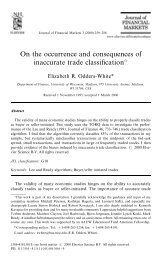A generic framework for Arabic to English machine ... - Acsu Buffalo
A generic framework for Arabic to English machine ... - Acsu Buffalo
A generic framework for Arabic to English machine ... - Acsu Buffalo
Create successful ePaper yourself
Turn your PDF publications into a flip-book with our unique Google optimized e-Paper software.
4.3. BASIC MACHINE TRANSLATION STRATEGIES<br />
To apply our <strong>framework</strong> <strong>to</strong> other generation languages, we only need <strong>to</strong> change the gen-<br />
eration phases. The intermediate representation is independent of the target language,<br />
and this is the benefit of using an Interlingua approach, since analysis and generation are<br />
separate tasks which are implemented independently.<br />
4.3.4 Transfer systems<br />
Transfer systems are a middle course between direct and Interlingua MT strategies.<br />
Transfer systems divide translation in<strong>to</strong> steps which clearly differentiate source lan-<br />
guage and target language parts. In the transfer approach there is there<strong>for</strong>e no language-<br />
independent representation: the source language intermediate representation is specific<br />
<strong>to</strong> a particular language, as is the target language intermediate representation. There is no<br />
necessary equivalence between the source and target intermediate representations <strong>for</strong> the<br />
same language. In the transfer strategy a source language sentence is first parsed in<strong>to</strong> an<br />
internal representation. Thereafter a transfer is made at both lexical and structural levels<br />
in<strong>to</strong> equivalent structures of the target language. In the third stage a translation is gener-<br />
ated. Whereas the Interlingua approach requires complete resolution of all ambiguities<br />
in the source language text so that translation in<strong>to</strong> any other language is possible, in the<br />
transfer approach only those ambiguities inherent in the language in question are tackled.<br />
This approach is a development over direct translation and this was lexically driven. The<br />
level of transfer differs from system <strong>to</strong> system - the representation varies from only syn-<br />
tactic deep structure <strong>to</strong> syntactic-semantic interpret trees. A multilingual transfer model<br />
with eight languages pairs is presented in Figure 4.3.<br />
In comparison with the Interlingua system there are clear disadvantages in the transfer<br />
approach. The addition of a new language involves not only the two modules <strong>for</strong> analy-<br />
sis and generation, but also the addition of new transfer modules, the number of which<br />
53
















